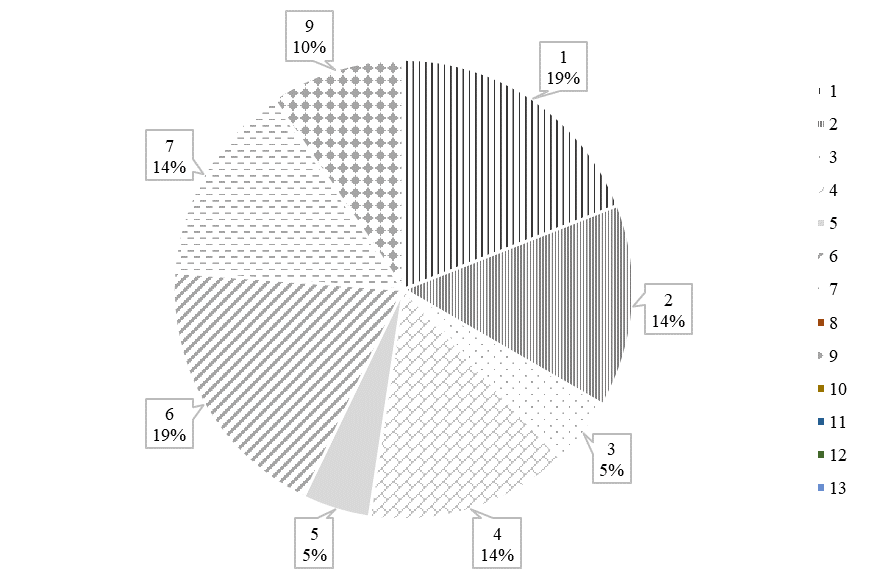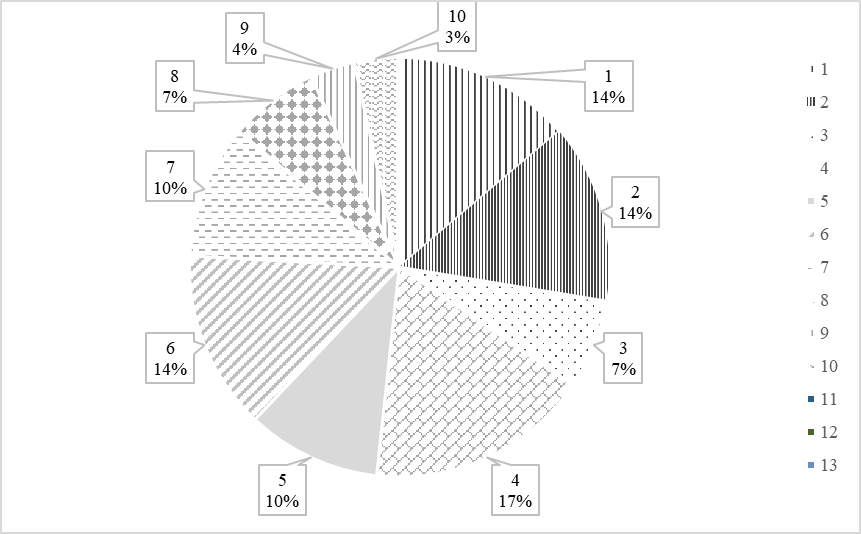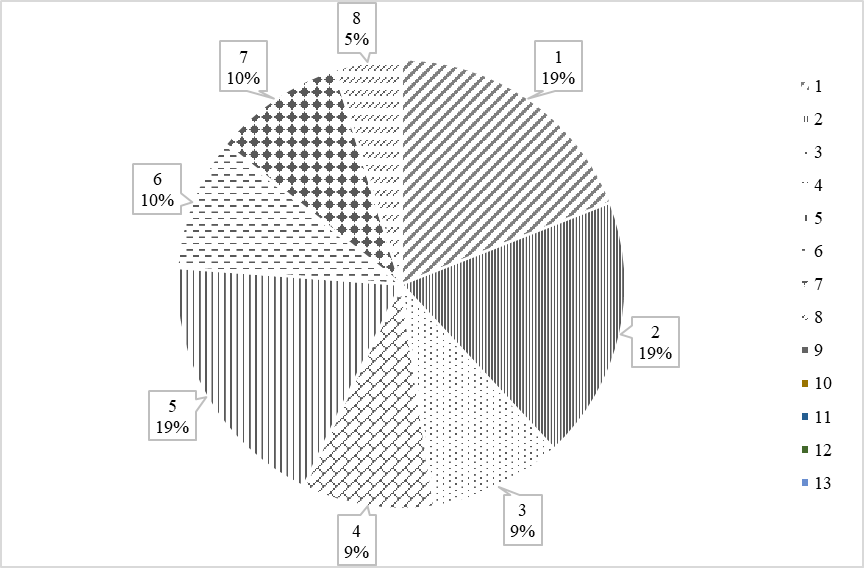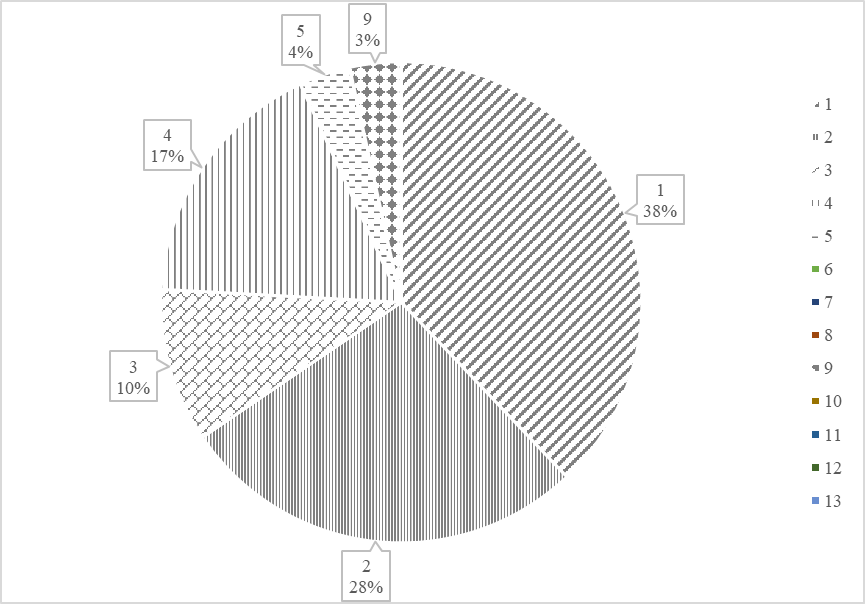Abstract
The development of motor skills corresponds with the cognitive development of a child. In motor learning, the acquisition, refinement and stabilization of motor skills is achieved. Children with mild mental disorder are nowadays included in the intact population as part of compulsory school education. Will be found statistically significant differences between group of intact children and children with mild mental disorder attending compulsory school education? The aim of the research is to describe the primary motor skills, which are an indicator of gross motor development, in children with diagnosed mild mental disorder (MID). The minor aim is to describe the differences between the level of motor skills of children with MID and children from intact population. The experimental group consisted of 62 children primary school age with mild mental disabilities and a control group of 76 children from the intact population primary school age. The level of motor skills was determined by TGMD-2 test. The significance of the difference between the sub-tests and gender differences in the level of motor skills were evaluated by the t-test. Data was collected within the project GF_PdF_2019_0003. A statistically significant difference was found between both sets in the level GMDQ (p≤0.001) and between locomotor and object control skills of group with mild mental disorder (p≤0.001). As part of compulsory school attendance, it is necessary to devote individual attention to the development of children's motor skills with diagnosed mild mental disabilities.
Keywords: Childintelectuall disabilitymotoricscompulsory school
Introduction
Movement, as one of the basic attributes of life, represents a natural and necessary load for the organism. Physical activity is one of those factors that are strongly involved in human phylogenesis and ontogenesis. The changes proceed at the cellular and organ level and are reflected in the improvement of the structure and function of the organ systems. For a child, movement is an irreplaceable factor in shaping, potentiating and regulating development, but it also serves as a certain criterion for controlling the course of dynamic changes in growth and general development. At the same time, the degree of movement evolves and the degree of talent to react independently to new stimuli and situations, which enables, among other things, to get actively involved into interactions with the environment. Disrupting a child from physical activity in the early stages of life, reducing space for physical activity or removing incentives for physical activity disrupts his/ her somato-mental development. Between the ages of 3 and 6, there is a link between the later acquisition of walking skills and atypical development of language abilities (Trauner, Wulfeck, Tallal, & Hesselink, 2000; Karasik, Tamis‐LeMonda, & Adolph, 2014; Walle & Campos, 2014; Zwaigenbaum, Bryson, & Garon, 2013). In the pre-school age, a number of important movement schemes are created or further developed, eg activities developing the dexterity of the limbs - gripping, lifting, carrying, holding, kicking etc. and activities developing the overall dexterity, rolling, etc.
Motor development is closely related to the development of executive and cognitive functions in both preschool and primary school children (Aadland et al., 2017; Farmer, Golden, & Thurm, 2015; Watson, Crais, Baranek, Dykstra, & Wilson, 2013). If there are problems in the development of motor skills during the child’s development, then it is possible to deduce problems in the area of executive functions, coordination, behavior and social adaptability and others (Gammer et al., 2014; Watson et al., 2011). Cognitive impairment is demonstrated by impaired concentration of attention, difficulty in the auditory and visual aspect. The child shows motor clumsiness and visual-motor coordination is impaired (Sugden, Kirby, & Dunford, 2008; Livesey, Keen, Rouse, & White, 2006; Williams, Whiten, & Singh, 2004). The motor behavior of these children is disorganized and discontinuous. The disturbance of executive functions is manifested by the inability to organize an activity, complete a task or game, plan or structure leisure time. There are also disturbances in the perception of chronological and visual-contextual relations, disturbances in verbal expression and impaired verbal and working memory. However, the level of these indicators is usually part of the assessment of the child's readiness for compulsory school education. Deficiencies in these areas are gradually manifested not only in the failure of the child during primary school education, but often also cause low social attractiveness of the child in a group of classmates and contribute to low self-esteem (Adolph & Robinson, 2013; Clearfield, 2011; Oliver, Schofield, Kolt, & McLachlan, 2007; Smith et al., 2013).
Insufficiency of brain functions characterized by decreased level of cognitive processes, different development of some psychic functions and lower social adaptability is called mental disability. According to the International Statistical Classification of Diseases and Related Health Problems (ICD-10, subsection F70) (WHO, 2016), mild mental disorder is the lightest form, which causes, among other things, school problems for a child. Lejčarová (2011) finds differences in psychological development in children with MID far greater than in motor development, which occurs in children with mild mental disorder (further MID) according to the same developmental patterns, only the onset of each stage is later and stay in them is intact longer population. The motor development of these children is much more linked to cognitive processes and speech than children from the intact population. Early intervention is important to support both motor and cognitive development of the child, as well as appropriate motivation and use of effective educational methods (Bishop, 2014; Houwen, Visser, van der Putten, & Vlaskamp, 2016).
Problem Statement
In the Czech Republic, children diagnosed with mild mental disabilities usually attend regular primary schools (Školský zákon, 2017). The act lays down the principles of equal access to education for every citizen of the Czech Republic or another Member State of the European Union without discrimination of any kind, including discrimination on the basis of human health. One of the objectives of compulsory primary school education, set out in the curriculum of education (Rámcový vzdělávací program pro základní vzdělávání, 2017), is to teach children to actively develop and protect their physical health and to be responsible for it. Given the legislation for compulsory education in the Czech Republic and the currently preferred inclusive educational process at primary schools, there is a need for a closer examination of the motor skills of pupils with mild mental disabilities. Although the education of children with MID is regulated by legislation, significant differences in motor development between children with MID and children from an intact population would require further significant adjustments to the curriculum of the compulsory subject Physical Education. The results of a number of researches in this field could serve as a basis for finding forms of education in the implementation of school physical education and meeting its objectives in the context of health promotion education of the youngest age categories.
Research Questions
-
Is there a difference in the level of both locomotion and object control skills in children with MID?
-
Will primary school age children diagnosed with MID show gender differences in the level of gross motor skills?
-
Will the differences between children with MID and children from intact population at the level of gross motor skills be confirmed?
Purpose of the Study
The main aim of the research is to describe the primary motor skills, which are an indicator of gross motor development, in children with diagnosed mild mental disorder. The minor aim is to describe the differences between the level of motor skills of children with MID and children from intact population.
Research Methods
The research group consisted of 62 pupils from primary schools (23 girls, 39 boys) with diagnosed mild mental disorder. Average age of pupils of research group was 9,66±0,49 years (girls 9,77±0,56, boys 9,54±0,42). The research group of children from the intact population consisted of 76 children from primary schools (38 girls, 38 boys) in average age 9,67 ±0,58 (girls 9,82±0,43, boys 9,53±0,73). Only children whose legal representatives agreed to participate in the research were included in the research; participation was free of charge and voluntary, at the discretion of parents. They were informed about the aims, methods and realization of the research, the anonymity of the obtained data was declared and the rules of research ethics were observed. Data were collected within the project GF_PdF_2019_0003. The project was authorized by Ethical Committee of author‘s authorities. The data collection was done in the environment of regular elementary schools. Children were adequately acquainted with the objective of the research, they could interrupt or interrupt their participation at any time. During the testing, children’s reactions were monitored and the rules of mental hygiene of activities were observed. The level of motor skills was determined by TGMD-2 test (Ulrich, 2000). The test monitors the level of locomotion and object control motor skills and results are converted in the context of the child's age by a standard score and then to the gross motor development quotient (GMDQ), which is an indicator of the level of motor development. The results of the individual relative to the population are expressed as percentiles. The TGMD-2 test is used in various contexts in the research, but the studies are mostly focused on searching for possibilities to influence gross motor skills (Bardid et al., 2013; Houwen, Hartman, Jonker, & Visscher, 2010). It can also be used in mentally handicapped people (Eguia, Capio, & Simons, 2015). The significance of the difference between the sub-tests (locomotor skills and object control skills) of children with mild mental disorder was evaluated by the t-test. Gender differences in the level of motor skills were evaluated by the Mann-Whitney test. The results were evaluated at the level of statistical significance p ≤0.05.
Findings
In the locomotion skills subtest, subgroup of children with MID achieved a mean score of 4 points. Of the total MID population, more than half of the research group achieved only 1 or 2 standard scores (1–26 points) - the lowest possible TGMD-2 standard score, which equals to 1 percentile of population and age 4, 3 years or less. A total of 23.33 % of children achieved a score of 7–10 (33–41 points), which corresponds to a 16–50 percentile and an age equivalent of 5.0–6.9 years. No proband reached higher values. The maximum achievable standard score in locomotion skills relative to the age of the probands is 13 (corresponding to the 84th percentile), but none of the probands has reached this value (Table
The group of children from the intact population (further IP) reached the GMDQ in average of 85.51 (descriptive ratings of scores were in the category below average). Boys showed worse overall results (83.74) than girls (87.29), but no significant difference was confirmed (p = 0.09). There were no gender differences in locomotor skills - both groups showed the highest representation in the 7-10 standard score category (38-44 points) (Table

Notes:
1, 2, 3, 4, 5,….11 … standard scores of locomotor skills
8, 10, 11, 12, 13 … standard scores = 0 % persons

Notes:
1, 2, 3, 4, 5,….10 … standard scores of locomotor skills
11, 12, 13 … standard scores = 0 % persons

Notes:
1, 2, 3, 4, 5,… … standard scores of object control skills; 9, 10, 11, 12, 13, 14, 15 … standard scores = 0 % persons

Notes:
1, 2, 3, 4, 5,… … standard scores of object control skills; 6, 7, 8, 10, 11, 12, 13 … standard scores = 0 % persons
Conclusion
The development of motor skills and its impact on the school success of a child is a current subject of many researches. If problems are detected in the right time, it would be possible to intervene with appropriate education programs in early age categories and prepare the child for compulsory school education. A significant difference was found between the level of locomotor and object control skills in the group of children with MID in favor of locomotion skills. Gender differences in children with MID have not been confirmed in terms of locomotor or object control skills. However, significant differences in the level of motor skills were found between children with MID and children from IP, and it can be assumed that in preferred inclusive education, a lower level of motor skills may affect the success of a child in compulsory education. Supporting the development of gross motor skills in children with MID could help adapt to compulsory school education and facilitate integration into the group of classmates, as well as greater involvement in leisure activities with peers from the intact population. Motor skills problems must also be taken into account during basic education, where physical and health education is a compulsory subject. Teachers should individually develop the motor skills of children with mild mental disabilities, search and develop methods and procedures for working with children with this type of disability.
References
- Aadland, K. N., Moe, V. F., Aadland, E., Anderssen, S. A., Resaland, G. K., & Ommundsen, Y. (2017). Relationships between physical activity, sedentary time, aerobic fitness, motor skills and executive function and academic performance in children. Mental Health and Physical Activity, 12, 10-18.
- Adolph, K. E., & Robinson, S. R. (2013). The road to walking: What learning to walk tells us about development. In P. Zelazo (Ed.), Oxford Handbook of Developmental Psychology. NY: Oxford University Press.
- Basterfield, L., Adamson, A. J., Frary, J. K., Parkinson, K. N., Pearce, M. S., & Reilly, J. J. (2011). Longitudinal Study of Physical Activity and Sedentary Behavior in Children. Pediatrics, 127(1), e24-e30
- Bishop, M. (2014). Motor. Evidence-Based Treatment for Children with Autism (261-272).
- Butte, N. F., Gregorich, S. E., Tschann, J. M., Penilla, C., Pasch, L. A., De Groat, C. L., ... & Martinez, S. M. (2014). Longitudinal effects of parental, child and neighborhood factors on moderate-vigorous physical activity and sedentary time in Latino children. International Journal of Behavioral Nutrition and Physical Activity, 11(1), 108.
- Clearfield, M. W. (2011). Learning to walk changes infants' social interactions. Infant Behavior and Development, 34, 15– 25.
- Eguia, K. F., Capio, C. M., & Simons, J. (2015). Object control skills influence the physical activity of children with intellectual disabilities in a developing country: The Philippines. Journal of Intellectual and Developmental Disability, 40(3), 265-274.
- Farmer, C., Golden, C., & Thurm, A. (2015). Concurrent validity of the Differential Ability Scales, second edition, with the Mullen Scales of Early Learning in young children with and without neurodevelopmental disorders. Child Neuropsychology: A Journal on Normal and Abnormal Development in Childhood and Adolescence, 1, 1–14.
- Field, S. C., & Temple, V. A. (2017). The Relationship between Fundamental Motor Skill Proficiency and Participation in Organized Sports and Active Recreation in Middle Childhood. MDPI Open access journals [online]. School of Exercise Science, Physical and Health Education, University of Victoria, Victoria, Canada, 2017 [cit. 2019-07-23]. Available from http://www.mdpi.com/2075-4663/5/2/43/htm
- Gammer, I., Bedford, R., Elsabbagh, M., Garwood, H., Pasco, G.,Tucker, L., Volein, A., Johnson, M. H., Charman, T., & The BASIS Team (2015). Behavioural markers for autism in infancy: Scores on the Autism Observational Scale for Infants in a prospective study of at-risk siblings. Infant Behavior & Development 38(2015), 107–115
- Houwen, S., Visser, L., van der Putten, A., & Vlaskamp, C. (2016). The interrelationships between motor, cognitive, and language development in children with and without intellectual and developmental disabilities. Research in Developmental Disabilities, 53, 19-31.
- Houwen, S., Hartman, E., Jonker, L., & Visscher, C. (2010). Reliability and Validity of the TGMD-2 in Primary-School-Age Children with Visual Impairments. Adapted physical activity quarterly, 27(2), 143-159.
- Jaakkola, T., Yli-Piipari, S., Huotari, P., Watt, A., & Liukkonen, J. (2015). Fundamental movement skills and physical fitness as predictors of physical activity: A 6-year follow-up study. Scandinavian Journal of Medicine & Science in Sports, 26(1), 74–81.
- Jeounq, B. J. (2013). Objective control skills among students with intellectual disability at special school in Korea. National center for biotechnology information [online]. 2013 [cit. 2019-07-23]. Available from https://www.ncbi.nlm.nih.gov/pubmed/24282808
- Karasik, L. B., Tamis‐LeMonda, C. S., & Adolph, K. E. (2014). Crawling and walking infants elicit different verbal responses from mothers. Developmental Science, 17, 388– 395.
- Lejčarová, A. (2011). Motorická výkonnost dětí s lehkým intelektovým postižením [Motor performance of children with mild intellectual disabilities]. Praha: Karolinum.
- Livesey, D., Keen, J., Rouse, J., & White, F. (2006). The relationship between measures of executive function, motor performance and externalising behaviour in 5- and 6-year-old children. Human Movement Science, 25, 50–64.
- Loprinzi, P. D., Davis, R. E., & Fu, Y. C. (2015). Early motor skill competence as a mediator of child and adult physical activity. Preventive Medicine Reports, 2, 833–838.
- Nonis, K., & Tan, T. S. Y. (2014). The gross motor skills of children with mild learning disabilities. International Journal of Special Education, 29(2), 92-97.
- Oliver, M., Schofield, G. M., Kolt, G. S., & McLachlan, C. (2007). Physical Activity in Early Childhood: Current State of Knowledge. New Zealand Research in Early Childhood Education, 10, 47-68.
- Rámcový vzdělávací program pro základní vzdělávání [Framework Education Program of Preschool Education] (2017). Národní ústav pro vzdělávání, Praha.
- Ross, S. M., Case, L., & Leung, W. (2016). Aligning Physi-cal Activity Measures with the International Classifica-tion of Functioning, Disability and Health Framework for Childhood Disability. Quest, 68(4), 521–535.
- Smith, A. L., Hoza, B., Linnea, K., McQuade, J. D., Tomb, M., Vaughn, A. J., Shoulberg, E. K., & Hook, H. (2013). Pilot Physical Activity Intervention Reduces Severity of ADHD Symptoms in Young Children. Journal of Attention Disorders, 17(1), 70-82.
- Sugden, D., Kirby, A., & Dunford, C. (2008). Issues aurrounding children with Developmental Coordination Disorder. International Journal of Disability, Development and Education, 55(2), 173-187.
- Školský zákon (2017). ZÁKON 561/2004 Sb. ze dne 24. září 2004 o předškolním, základním, středním, vyšším odborném a jiném vzdělávání (školský zákon) [ACT 561/2004 Coll. of 24. September 2004 on pre-school, primary, secondary, tertiary professional and other education (Education Act)]. Available from: http://www.msmt.cz/dokumenty-3/skolsky-zakon
- Trauner, D., Wulfeck, B., Tallal, P., & Hesselink, J. (2000). Neurological and MRI profiles of
- children with developmental language impairment. Developmental Medicine and Child Neurology, 42, 470-475.
- Ulrich, D. (2000). The Test of Gross Motor Development-2 (2nd edition). Austin: PROD-ED.
- Vuijk, P. J., Hartman, E., Scherder, E., & Visscher, C. (2010). Motor performance of children with mild intellectual disability and borderline intellectual functioning. Journal of Intellectual Disability Research 54(11), 955-965.
- WHO Library Cataloguing-in-Publication Data. (2016). International statistical classification of diseases and related health problems (10th revision, Fifth edition).
- Walle, E. A., & Campos, J. J. (2014). Infant language development is related to the acquisition
- of walking. Developmental Psychology, 50, 336–348.
- Watson, L. R., Crais, E. R., Baranek, G. T., Dykstra, J. R., & Wilson, K. P. (2013). Communicative gesture use in infants with and without autism: A retrospective home video study. American Journal of Speech-Language Pathology, 22, 22-39.
- Watson, L. R., Patten, E., Baranek, G. T., Poe, M., Boyd, B. A., Freuler, A., & Lorenzi, J. (2011). Differential associations between sensory response patterns and language, social, and communication measures in children with autism or other developmental disabilities. Journal of Speech, Language and Hearing Research, 54(6), 1562-1576.
- Westendorp, M., Hartman, E., Houwen, S., Smith, J., & Visscher, C. (2011). The relationship between gross motor skills and academic achievement in children with learning disabilities. Research in Developmental Disabilities, 32(6), 2773-2779.
- Williams, J. H. G., Whiten, A., & Singh, T. (2004). A systematic review of action imitation in autistic spectrum disorder. Journal of Autism and Developmental Disorders, 34, 285-299.
- Zikl, P., Holoubková, N., Karásková, H., & Veselíková, T. B. (2013). Gross motor skills of children with mild intellectual disabilities. World academy of science, engineering and technology, 82,1175-1181.
- Zwaigenbaum, L., Bryson, S., & Garon, N. (2013). Early identification of autism spectrum disorders. Behavioral and Brain Research, 25(1), 133-146. https://doi.org/10.1016/j.bbr.2013.04.004
Copyright information

This work is licensed under a Creative Commons Attribution-NonCommercial-NoDerivatives 4.0 International License.
About this article
Publication Date
07 November 2019
Article Doi
eBook ISBN
978-1-80296-071-6
Publisher
Future Academy
Volume
72
Print ISBN (optional)
-
Edition Number
1st Edition
Pages
1-794
Subjects
Psychology, educational psychology, counseling psychology
Cite this article as:
Miklánková, L. (2019). Problems Of Motor Skills Development Of Children With Mild Mental Disorder. In P. Besedová, N. Heinrichová, & J. Ondráková (Eds.), ICEEPSY 2019: Education and Educational Psychology, vol 72. European Proceedings of Social and Behavioural Sciences (pp. 447-457). Future Academy. https://doi.org/10.15405/epsbs.2019.11.54

